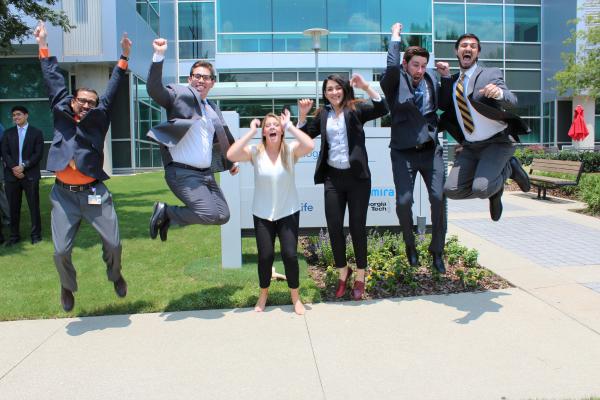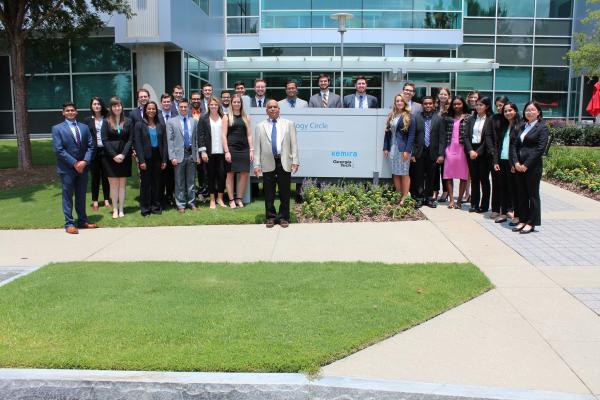The Master in Biomedical Innovation and Development (MBID) program was created in 2013 by the Wallace H. Coulter Department of Biomedical Engineering at Georgia Tech and Emory to fill a market need for innovative professionals thoroughly trained at the intersection of biomedical device engineering, healthcare, and business development.
“The MBID program filled all the knowledge gaps I didn't realize I had in the medical device lifecycle,” said Samir Jain, one of the students in this year’s graduating class. “Not only was it crucial to get a strong familiarity with the vernacular and nuances of the [medical device] industry, but also how to go through the components and requirements of a medical device lifecycle with an interdisciplinary team tasked with completing a year-long design project.”
At the end of July, five student teams wrapped up their final MBID projects with in-depth presentations to clinicians, faculty, industry leaders, and fellow students. Sathya Gourisankar, MBID program director, presided over the two-hour event and solicited challenging questions from the crowd.
“The MBID curriculum and training are founded on the twin pillars of real world exposure and start-up industry experience,” said Gourisankar. “This kind of focus has enabled the program to be very well accepted by the medical device industry, resulting in repeat hiring and requests for candidates from industry leaders such as J&J, Medtronic, Cook Medical, Facett and others.”
Before graduating, students must present the results of their bench to bedside product development efforts on medical devices. Project team therapeutic areas encompassed urology, spinal disc replacement, respiratory assistance, intensive care, and vascular surgery.
In all, five teams of students gave their project summaries as noted below:
* AbTeks: team members are Kali Chiapetta, Ossman Cossio, Brandon Graham, Samir Jain, and Anqi Tong. Clinical mentor: Pravin Reddy, M.D. The team developed Polar Compass, a cervical disc replacement device to treat cervical radicular pain at a lower cost than the gold standard along with strengthened durability and an innovative stabilization system. The Polar Compass utilizes readily available industrial magnets to restore and maintain disc height between cervical vertebrae five years longer than competitive devices while aiming to improve patient pain relief and quality of life. AbTeks is working with orthopaedic surgeons in Atlanta to streamline the usage of the device and reduce the burden of high reoperation rates of current procedures on the healthcare system.
* Adscensio: team members are Sahil Bellare, Elizabeth Coyle, Thomas Gallerani, Nicole Gervasi, Aaron Katz, and Filip Popovic. Clinical mentors: Lekshmi Kumar, M.D. and Samuel Shartar. The team developed G-Flex, a non-invasive ventilation device, to be used in the EMS setting as well as the hospital setting. In an ambulance, there are two people—one person driving and one person in the back. Devices on the market now are very difficult to use with one person and often lead to ventilation failure and resorting to invasive ventilation which has a high failure rate in the ambulance. G-Flex tackles the problem of a faulty seal around the airway leading to ventilation failure. G-Flex fixes this problem by replacing the thick non-elastic bladder with a thin but durable elastic bladder filled with IP-protected gel. This allows the bladder to spread across the face and better adapt to various facial structures and features. An additional feature is that the body of the device has a more ergonomic design for people with smaller hands to prevent ventilation failure from occurring due to lack of grip on the device. This device improves patient outcomes, saves time, money, and results in fewer patient complications.
* Grady Bunch: team members are Dan Bonistalli, Pranav Challa, Emily Macmillan, Koushal Patel, Houston Rhodes, Swetha Surianarayanan. Clinical sponsors: Spencer Kozinn, M.D.; Raymond Park, M.D., and Jaimie Wong, M.D. The Grady Bunch team developed Urolink which is a device that has been developed for use in prostate cancer cases requiring radical prostatectomies. The device allows for a more efficient method in the anastomosis between the bladder and the urethra after the removal of the prostate. This cuts down on procedural time reducing costs (or time), and allows for better outcomes with less complications.
* Macer Medical: team members are Rosalee Celis, Emily Churchwell, Alan Komisarcik, Roshni Malik, Megha Mathur. Clinical mentor: Gautam Kumar, M.D. It is estimated that 30 percent of patients undergoing an angiogram are diagnosed with chronic total occlusion (CTO) which is defined as a near-100% blocking of the coronary arteries. The current gold standard to treat CTO is through a coronary artery bypass graft which is a very invasive and costly surgery. Alternatively, patients may elect to treat CTO through a percutaneous coronary intervention (PCI) since this procedure is minimally invasive, cheaper, and requires less recovery time. However, the current PCI success rate to treat CTO is at 60 percent. Procedures typically fail because the physician can’t penetrate the proximal lesion cap to clear the blockage. The team proposed a technology to treat CTO via PCI known as Spyra. Their Spyra technology utilizes an electromagnetic probe inserted through the antegrade pathway. A guidewire inserted through the retrograde pathway is utilized to penetrate the distal lesion cap. Once the retrograde guidewire is at close proximity to the proximal cap, the electromagnetic probe which is part of the Spyra system is switched on to attract the guidewire with an additional magnetic “pull” force and helps to bring the guidewire successfully through the proximal cap. Afterwards, a stent can be deployed via balloon angioplasty.
* MEDLife Technologies: team members are Eric Beckelhymer, Felicia Canipe, Shima Habibollahzadeh, Josh Liebowitz, Saumitra Sinha Ray, and Christopher Silva. Clinical mentor: Prem Kandiah, M.D. The MEDLife Technologies team developed a technology, the Natria System, capable of improving sodium monitoring for neurocritical care patients. Current problems with the gold standard are mislabeling and lost samples, long lead times to read the samples, and over/under correction resulting in adverse events. This team identified a need to improve sodium monitoring by allowing the measurements to be performed in a patient’s room, at the bedside, via an ion specific sensor. The Natria System will reduce ICU admissions, prevent secondary brain injuries, reduce blood transfusions, reduce length of stay and decrease nurse workload. Upon adopting the Natria System, hospitals could increase their margins and prevent negative revenues since Natria can prevent secondary injuries from occurring. Currently, MedLife Technologies is trying to establish commercial potential through a health economics study which will also publicize their device in the arterial line space.
“As a student in the MBID program, I learned to connect the dots [in the biomedical device industry],” said Houston Rhodes, another student in this year’s graduating class. “Throughout the program, my vision for innovating medical devices to meet clinical needs was coupled with new knowledge on how to take concepts from ideation to commercialization. I learned high level information about the industry that I couldn't have gotten anywhere else.”
Josh Leibowitz achieved a rare honor following his recent graduation from MBID—he is one of only six master level engineers in the country accepted into the highly acclaimed and competitive Johnson & Johnson R&D Leadership Development Program in the company’s medical device division.
“It is my goal to be the CEO of a medical device company, but I wanted to acquire a fundamental knowledge of the medical device industry from concept to commercialization,” says Liebowitz. “I knew that if I wanted to lead a medical device project or company, the MBID cross-functional exposure would be very helpful. I was drawn by [the Coulter Department’s] reputation as the best biomedical engineering program in the country and its intimate partnership with Emory. I really enjoyed the clinical exposure, observing surgeries, and interacting with healthcare professionals.”
Another MBID graduate of this year’s class, Elizabeth Coyle, was recently among six Georgia Tech students, and only 10 nationally, selected to participate in the first Polish President Internship (May 24-June 4, 2017). The students spent 10 days traveling through Poland, visiting political and cultural sites in some of its greatest cities, as well as meeting with the president of Poland, Andrzej Duda. “From learning about R&D prototyping methods to learning about quality, regulatory, marketing, and business strategy, everything we learned is extremely applicable to the medical device industry,” says Coyle, who is from Cleveland, Tennessee. “I always tell people that I learned more in this one year of my graduate studies than I did in all four years of undergrad.”
Graduation photos.
Media Contacts:
Walter Rich
Communications Manager
Wallace H. Coulter Department of Biomedical Engineering
Georgia Institute of Technology
Media Contact
Walter Rich
Keywords
Latest BME News
Jo honored for his impact on science and mentorship
The department rises to the top in biomedical engineering programs for undergraduate education.
Commercialization program in Coulter BME announces project teams who will receive support to get their research to market.
Courses in the Wallace H. Coulter Department of Biomedical Engineering are being reformatted to incorporate AI and machine learning so students are prepared for a data-driven biotech sector.
Influenced by her mother's journey in engineering, Sriya Surapaneni hopes to inspire other young women in the field.
Coulter BME Professor Earns Tenure, Eyes Future of Innovation in Health and Medicine
The grant will fund the development of cutting-edge technology that could detect colorectal cancer through a simple breath test
The surgical support device landed Coulter BME its 4th consecutive win for the College of Engineering competition.









